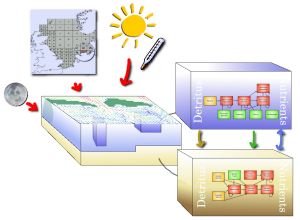
BioGeoChemistry of Tidal Flats
EcoTiM - Ecological Tidal Model
A coupled Euler-Lagrange Model for the back barrier system of spiekeroog on the base of ERSEM
|
EcoTiM is a complex ecosystem model which dynamically simulates the cycling of organic carbon, nitrogen, phosphate silicate and oxygen within the back barrier system of the East Frisian island Spiekeroog. The model has the capability to resolve the seasonal cycles as well as tidal processes. It consists of several interlinked modules describing the pelagic and benthic foodweb, the microbial loop including the distribution of detritus. The description of the biochemical and ecological processes bases mainly on ERSEM. |
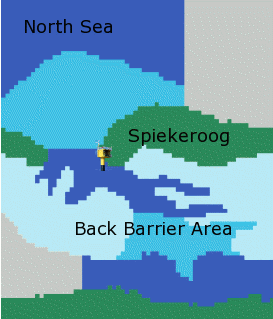
The model area and the location of the station. |
The transport model consists of a Lagrangian description of the water movement. The consideration of finite water bodies allows the mass conserving coupling to the benthic system. The benthic system is represented by different sediment areas defined according to topography and porosity. The model is driven by the North Sea application of ERSEM as boundary condition and forced by light and temperature.
The model reproduces the annual signal of the main nutrients as well as the variability within a tide. The gradients in the nutrient concentrations from higher values near the coast to lower concentrations offshore are reproduced by the simulation.
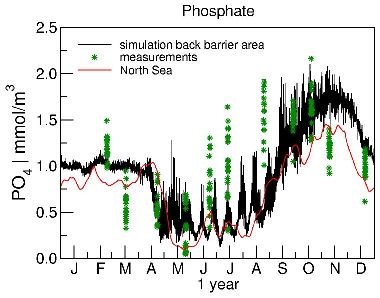
Simulated phosphate concentration in the back barrier area (black) compared to measurements (green, Liebezeit: unpublished data). The red line denotes the boundary condition of the North Sea.
The model allows sensitivity analyses on scales from several years down to some hours. Nutrient and organic matter concentrations, the abundancies of primary and secondary producers and bacteria in the pelagic and in the benthic system may be investigated. The estimation of mass flows and productivities and the investigation of extreme scenarios as storm tides and ice winters is possible.
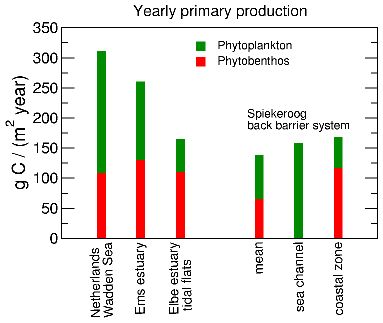
Yearly averaged primary production for different geographical regions as denoted in Elbrächter et al. 1994 compared to the simulations of EcoTiM for different regions within the back barrier system of Spiekeroog. The part of production due to phytobenthic activity is marked red.
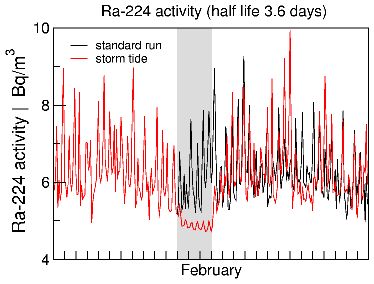
Simulated Radium-224 activity within the back barrier system. The black line shows a ''normal'' situation, the red line a storm tide. The duration of the storm is marked grey. The activity decreases during storm due to incoming sea water and due to the increasing sea level within the back barrier area. This leads to a relatively smaller impact of the benthic efflux.
Relevant publications
- Kohlmeier, C.: Modellierung des Spiekerooger Rückseitenwatts mit einem gekoppelten Euler-Lagrange-Modell auf der Basis von ERSEM. 2004. 224 S. Dissertation, Carl von Ossietzky Universität Oldenburg
- Ebenhöh W, Kohlmeier C, Baretta JW, Flöer G (2004) Shallowness may be a major factor generating nutrient gradients in the Wadden sea. Ecological Modelling 174 (3): 241-252
- Kohlmeier C (2003) ECOTIM - Ecological tidal model. In Rullkötter J. (ed.), BioGeoChemistry of Tidal Flats - Proceedings of a Workshop held at the Hanse Institute of Advanced Study, Delmenhorst (Germany), 14-17 May. Forschungszentrum Terramare, Wilhelmshaven, Berichte Nr. 12, 77-80. ISSN 1432-797X.
| More details
|
